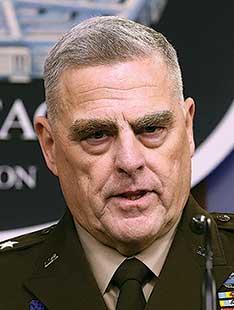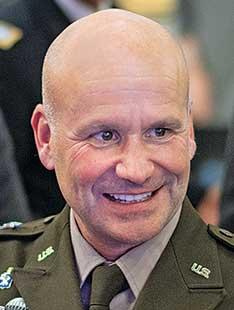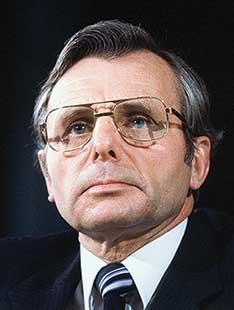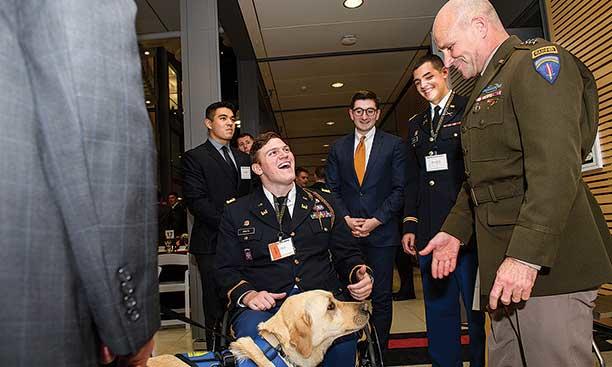Centennial Celebration: University Marks 100th anniversary of ROTC, Honoring Those Who Have Served
In 1919, one of the first permanent peacetime ROTC units in the country was established at Princeton, formalizing the wartime military training that had taken place on campus during World War I. One hundred years later, members of the University affiliated with the military — including current ROTC students, ROTC alumni, and veterans — gathered with administrators, students, and others to celebrate the unit’s centennial.
The more than 200 people who attended the anniversary events Nov. 11 “collectively represent over 1,000 years of service in uniform to our country,” said deputy dean of the College Elizabeth Colagiuri *99, a former Naval ROTC member at Cornell who served five years on active duty.
“This unbroken century-long tradition is a source of great pride for this University and for me personally,” said President Eisgruber ’83. “Princeton’s ROTC programs have trained generations of leaders who have served this country — and continue to serve this country — with courage, wisdom, and integrity.” Gen. Mark A. Milley ’80, who in October became chairman of the Joint Chiefs of Staff, the nation’s highest-ranking military officer, addressed the attendees in a video.
Retired colonel Doug Lovejoy *68, who once commanded the Army ROTC unit, received the ROTC Alumni Service Award for his work establishing the Alumni and Friends of Princeton ROTC.
“Our country deserves the service of the young men and women who attend an institution as respected and as quality as this one,” said keynote speaker Lt. Gen. Christopher Cavoli ’87, commanding general of the U.S. Army Europe since 2018.
Alumni, who came from as far away as Hawaii to attend, looked through the ROTC memorabilia on display as they reflected on their experiences. Raymond Young ’64, who has worked as a business executive and for the federal government, said the instruction in leadership he received in Army ROTC while he was an undergraduate was “absolutely invaluable. No matter what you do in society, that leadership training helps you.”
Douglas Prager ’82, who served in the Army for 23 years as a doctor after his ROTC training, said, “The most important thing was the discipline ROTC gave me to do things I wasn’t comfortable doing.”
William Lucas ’71 — known as Charlie as an undergraduate — recalled the challenges of being in ROTC during the Vietnam War. “Wearing an ROTC uniform on campus was polarizing,” he said. “Princeton was very split. Students in the ROTC community became very close-knit.” After college, Lucas served in the infantry and counterintelligence.
At its founding in 1919, the ROTC unit had eight Army officers, 30 enlisted men, and 90 horses. In the following two decades, it grew to comprise an estimated 25 percent of the undergraduate student body.
After the bombing of Pearl Harbor, an accelerated academic program was created on campus so that ROTC cadets could graduate more quickly and join the war effort. Six months after the attack, more than 2,000 alumni were serving in the armed forces. By the war’s end, 355 Princetonians would be killed.
This year, 67 students serve in ROTC: 47 in the Army, 13 in the Navy, and seven in the Air Force.
ROTC added a naval unit in 1946 with 115 midshipmen and an Air Force unit in 1951 with 89 students. By 1951, one-third of the undergraduate student body was involved in ROTC. But enrollment declined in the 1960s as tensions over the Vietnam War grew. In May 1970, the U.S. bombing of Cambodia led to huge protests on campus, and the ROTC offices at the armory were firebombed. Soon after, the University’s faculty voted to eliminate ROTC.
Army ROTC experienced just a one-year hiatus — it was reinstated in 1972. The Air Force unit was reinstated in the 1980s. The Navy unit did not return until 2014. Controversy over the military’s “don’t ask, don’t tell” policy led the faculty to vote in 1993 to remove ROTC from campus, but the Board of Trustees did not accept the resolution. In the last couple of decades, enrollment has ranged from under a dozen students per year to a few dozen.
This year, 67 Princeton students serve in ROTC: 47 in the Army, 13 in the Navy, and seven in the Air Force.
Army cadets spend 10 to 14 hours a week in ROTC class time, outdoor training, physical fitness training, and homework, said Lt. Col. Courtney Jones, director of the Army Officer Education Program. Freshmen and sophomores spend additional time in mentoring and rehearsing for events, while juniors and seniors spend additional time in planning, coordination, and training meetings. Students also devote several weekends to field exercises and marksmanship training at Fort Dix and West Point. Cadets are evaluated on leadership, character, and retention of coursework and training, Jones said.
Notable Princeton ROTC Alumni

















1 Response
George Bustin ’70
6 Years AgoTiger Cheers for the 100th Anniversary of ROTC at Princeton
Co-president of the Class of 1970 Mickey Pohl and I were delighted to see the PAW article on the ROTC centennial celebration (On the Campus, Dec. 4), with some of Princeton’s most illustrious ROTC graduates highlighted. Our 50th-reunion class is one of the very few in recent history to have three flag officers represented among our number, one for each service: Marine Maj. Gen. Drew Davis ’70, Navy Rear Admiral Kirk Unruh ’70, and Army Brig. Gen. Steve Xenakis ’70, all of whom were present for the centennial event.
We are very proud of these and other classmates who participated in ROTC during our college years and served the nation for decades thereafter; they were honored at the celebration as they honored it with their presence.